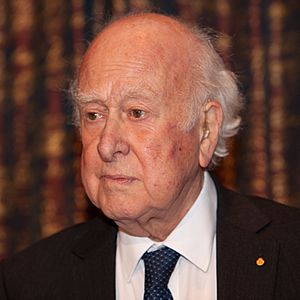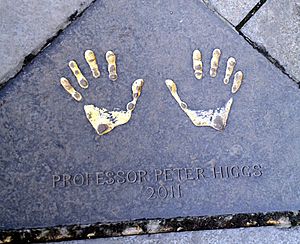Peter Higgs facts for kids
Quick facts for kids
Peter Higgs
|
|
|---|---|

Higgs in 2013
|
|
| Born |
Peter Ware Higgs
29 May 1929 Newcastle upon Tyne, England
|
| Died | 8 April 2024 (aged 94) Edinburgh, Scotland
|
| Nationality | British |
| Alma mater | King's College London University of London (BSc, MSc, PhD) |
| Known for | Higgs boson Higgs field Higgs mechanism Symmetry breaking |
| Spouse(s) |
Jody Williamson
(m. 1963) |
| Children | 2 |
| Awards |
|
| Scientific career | |
| Fields | Theoretical physics |
| Institutions | University of Edinburgh Imperial College London University College London King's College London |
| Thesis | Some problems in the theory of molecular vibrations (1955) |
| Doctoral advisors | Charles Coulson Christopher Longuet-Higgins |
| Doctoral students |
|
| Signature | |
Peter Ware Higgs (1929–2024) was a famous British theoretical physicist. He was a professor at the University of Edinburgh. He won the Nobel Prize in Physics for his important work.
Higgs helped us understand how tiny particles get their mass. In the 1960s, he suggested a way that particles could gain mass. This idea is called the Higgs mechanism. It predicted a new particle, the Higgs boson. Finding this particle became a major goal for scientists.
On July 4, 2012, scientists at CERN found the Higgs boson. They used a huge machine called the Large Hadron Collider. This discovery proved Higgs's idea was right. The Higgs mechanism is now a key part of the Standard Model of particle physics. Without it, some particles would have no mass at all.
Higgs received many awards for his work. These included the Hughes Medal and the Wolf Prize in Physics. In 2013, he shared the Nobel Prize in Physics with François Englert. He was also given the Copley Medal in 2015, which is a very old science prize.
Contents
Early Life and Education
Peter Higgs was born in Newcastle upon Tyne, England, on May 29, 1929. His father was a sound engineer for the BBC. Because his family moved often and due to World War II, Peter missed some school. He was taught at home for a while.
He attended Cotham Grammar School in Bristol from 1941 to 1946. There, he was inspired by Paul Dirac, another famous physicist. Dirac was one of the founders of quantum mechanics.
In 1946, at age 17, Higgs went to the City of London School. He focused on mathematics there. Then, in 1947, he studied physics at King's College London. He earned his first degree in 1950 and a master's degree in 1952. He completed his PhD in 1954. His research was about how molecules vibrate.
Career and Research
After his PhD, Higgs worked at the University of Edinburgh from 1954 to 1956. He then held jobs at Imperial College London and University College London. In 1960, he returned to the University of Edinburgh as a lecturer. He loved Edinburgh and the Scottish Highlands.
He became a professor of theoretical physics in 1980. He retired in 1996 but remained an Emeritus professor. This means he kept his connection to the university.
The Higgs Field and Mass
At Edinburgh, Higgs became very interested in how particles get their mass. He developed an idea that particles were massless when the universe began. A tiny fraction of a second later, they gained mass. This happened by interacting with a special field. This field became known as the Higgs field.
Higgs believed this field fills all of space. It gives mass to all tiny particles that interact with it. Imagine walking through thick mud; the mud slows you down. The Higgs field is a bit like that mud for particles.
The idea for Higgs's work came from Yoichiro Nambu. Nambu had a theory called spontaneous symmetry breaking. However, his theory predicted particles with no mass. This was not correct for all particles.
Higgs found a way around this problem. He realized that massless particles might not appear in certain situations. He wrote a paper about this in 1964. It was published in a journal called Physics Letters.
He then wrote a second paper describing his theoretical model. This model is now called the Higgs mechanism. The paper was first rejected by Physics Letters. The editors thought it was "of no obvious relevance to physics." But Higgs added more details and sent it to Physical Review Letters. This journal published it later in 1964. This paper predicted a new, massive particle: the Higgs boson.
Other physicists, like Robert Brout, François Englert, Gerald Guralnik, C. R. Hagen, and Tom W. B. Kibble, had similar ideas around the same time. Their papers were also very important.
Finding the Higgs Boson
On July 4, 2012, CERN announced a huge discovery. Their ATLAS experiment and CMS experiments found strong evidence of a new particle. This particle was likely the Higgs boson. It had a mass of about 126 GeV.
Higgs was amazed by the news. He said, "It's really an incredible thing that it's happened in my lifetime." This discovery happened at the same place where his paper was once rejected!
Awards and Honors
Peter Higgs received many awards and honors for his groundbreaking work.
Civic Awards
In 2011, Higgs received the Edinburgh Award. This award honors people who have made a big positive impact on the city of Edinburgh. He was the fifth person to get this award.
He was given a special engraved cup in a ceremony in 2012. His handprints were also placed in stone in the City Chambers quadrangle. This is where the handprints of other Edinburgh Award winners are kept.
Higgs also received the Freedom of the City of Bristol in 2013. In 2014, he was given the Freedom of the City of Newcastle upon Tyne. A brass plaque honoring him was placed on the Newcastle Quayside.
Higgs Centre for Theoretical Physics
On July 6, 2012, the University of Edinburgh opened a new center named after Professor Higgs. It is called the Higgs Centre for Theoretical Physics. This center brings scientists from all over the world together. They work to understand "how the universe works" more deeply. The university also created a special professorship in his name.
Nobel Prize in Physics
On October 8, 2013, it was announced that Peter Higgs and François Englert would share the 2013 Nobel Prize in Physics. They won for their "theoretical discovery of a mechanism that contributes to our understanding of the origin of mass of subatomic particles." This discovery was confirmed by the experiments at CERN.
Higgs actually went out to avoid the media on the day the prize was announced. He didn't have a mobile phone. An old neighbor told him the good news when he was on his way home.
Member of the Order of the Companions of Honour
Higgs turned down a knighthood in 1999. But in 2012, he accepted membership in the Order of the Companions of Honour. This is a special award that doesn't give a title. He later said he accepted it because he was told it was a personal gift from the Queen. He also felt that the honors system was sometimes used for political reasons.
Personal Life and Views
Peter Higgs married Jody Williamson in 1963. She was also an activist. They had two sons, Chris and Jonny, and two grandchildren. The family lived in Edinburgh.
Higgs was involved in the Campaign for Nuclear Disarmament (CND). This group worked against nuclear weapons. He left the group when it started campaigning against nuclear power too. He was also a Greenpeace member until they opposed genetically modified organisms.
In 2004, Higgs won the Wolf Prize in Physics. He shared it with Robert Brout and François Englert. However, he refused to travel to Jerusalem to accept the award. This was because it was a state event attended by the president of Israel. Higgs disagreed with Israel's actions in Palestine.
Higgs was an atheist. He didn't like the nickname "God particle" for the Higgs boson. He said it "reinforces confused thinking" for people who mix science and religion. He died in Edinburgh on April 8, 2024, at the age of 94.
Images for kids
See also
 In Spanish: Peter Higgs para niños
In Spanish: Peter Higgs para niños


